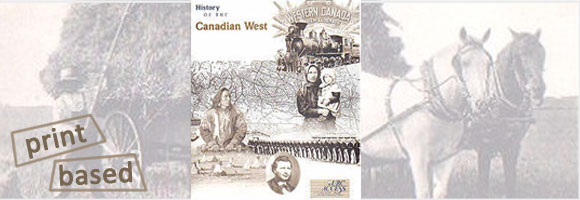
Mode of Delivery
This is a print-based, correspondence course.
Course Outline
- Six assignments
- Final examination options
Course Description and Prerequisites
Selected topics in the history of the Canadian West: First Nations people and the fur trade, Louis Riel, prairie settlement, and western social and political protest.
This course focuses on selected topics in the history of western Canada from 1670 to 1970. Among the included topics are: First Nations and the fur trade; women and fur trade society; colonial society in Red River and Fort Victoria; the west and Confederation; Indian Treaties, the North West Mounted Police and Louis Riel; the homestead experience; social reform, farm and labour protest; the rise of Social Credit and the Cooperative Commonwealth Federation; and the “new” West post-World War II. As the listed topics suggest the course is focussed more on the prairie than Pacific west. To help the student approach the readings and assignments with greater insight, the course begins with a discussion on the nature of historical enquiry.
Students considering the possibility of completing a major in History are reminded that they must have 6 units of History 100-299 or the equivalent from another institution and that their third- and fourth-year courses must be chosen in consultation with a departmental adviser.
Second-year students wishing to enrol in this course must first obtain permission from the instructor.
Course Overview
The first of the course’s ten lessons explores some answers to the question “what is history?” before going on to consider the influence of geography on the opening of the Canadian West to Europeans. In the first part of Lesson 2 we look at several aspects of the fur trade, first in relation to the indigenous population, then from a European perspective, and finally at its larger legacy for contemporary First Nations people and other Canadians; the second half of the lesson uses first-hand accounts for the study of fur trade society. Lesson 3 examines the relationship between the fur trade and the colonial development of the Red River and British Columbia. In Lesson 4 the entry of those two western regions into Confederation, and the problems attendant on their inclusion, are studied. Lesson 5 covers the transition from the old to the new west by focussing on three topics: the Indian treaties; law and order and the role of the North-West Mounted Police; and the place of Louis Riel in Canadian history. We move on in Lesson 6 to settlement of the west in the late nineteenth and early twentieth centuries, and consider the economic and social issues that prompted the drive to attract immigrants as well as the experiences of the settlers who came. The growth of reform ideas and movements in the west make up the major topics of Lesson 7 and the following lesson looks at the ways in which the Depression of the 1930s renewed the impetus for change begun a generation earlier. In Lesson 9 we consider the dynamic period of growth that followed the Depression and Second World War, both in the prairie West and British Columbia. The final lesson of the course, “The Canadian West in Retrospect,” reviews western Canadian history in search of notable themes and patterns that might help us refine our understanding of contemporary social and political issues.
Course Format
The course is organized on the basis of ten lessons, each developed around a broad theme or topic in Western Canadian history. Each lesson or topic is sub-divided into two or three parts that deal with more specific aspects of the broad topic being considered. Though it is intended that students will proceed through the materials at their own pace, a course schedule is provided to help you organize your activities according to the following time sequence; that is, one lesson completed approximately every three weeks. This would mean that you could work through the entire course in roughly thirty weeks.
Course Evaluation
There is an ungraded assignment early in the course, followed by six graded ones. The latter involve a variety of activities from writing a period journal and letter to the preparation of three short-to-moderate length essays (approx 1,250-2,500 words) and one term paper (3,500-4,000 words). The course may be completed in either of two ways:
a) a final essay of about 4,000-5,000 words (Lesson 11)
or
b) a three-hour invigilated examination (part one will be a short-answer question where you will be asked in a paragraph to identify and explain the historical significance of five out of nine names, events, or terms; the remaining two sections will require three essay answers to a selection of questions drawn previously from the list of study topics and questions which accompany each lesson.).
The 100 marks awarded for History 303 will be divided into the following percentages:
| Lesson 2 (journal assignment) | 15% |
| Lesson 4 (short essay) | 5% |
| Lesson 5 (short essay) | 5% |
| Lesson 6 (letter assignment) | 10% |
| Lesson 7 (term paper) | 25% |
| Lesson 10 (moderate essay) | 10% |
| Final exam or local history project | 30% |
|
Total |
100% |
Required Textbooks and Course Materials
Friesen, Gerald. The Canadian Prairies: A History. Toronto: University of Toronto Press, 1987.
Hallet, Mary, and Marilyn Davis. Firing the Heather: The Life and Times of Nellie McClung. Saskatoon: Fifth House Publishers, 1994. (now available as CCM at the UBC Bookstore)
Horn, Michiel. “The Great Depression of the 1930s in Canada”. Ottawa: Canadian Historical Association Booklet No. 39, 1984. (now available as CCM at the UBC Bookstore)
Custom Course Materials for HIST 303. Distance Education Section. UBC Bookstore. (This book has been compiled by the course author and is indexed to indicate the reading(s) required for each lesson).
HIST 303 Learner Package (includes course manual)
